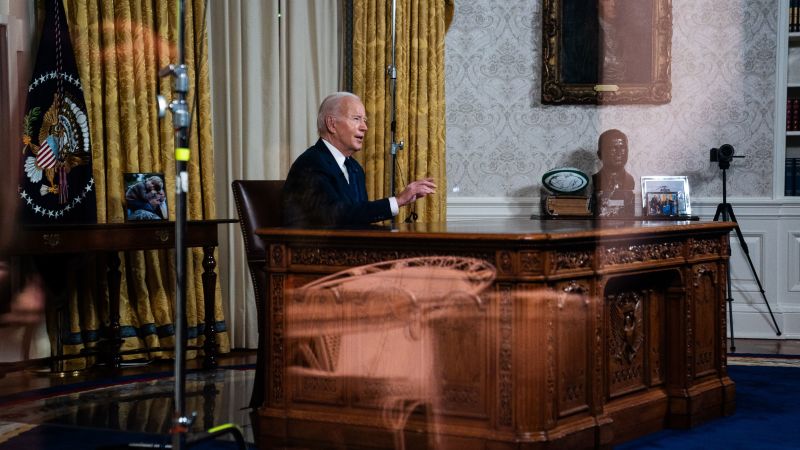

CNN
—
Weeks after the Biden administration laid out the details of a $105 billion national security package that includes funding for both Israel and Ukraine, Senate Majority Leader Chuck Schumer said he would bring the supplemental request to the floor as soon as next week.
But the effort faces steep hurdles in getting through Congress. Among them: The House and Senate are divided over whether to continue sending aid to Ukraine, and Republican lawmakers want to tie the funding to tightening immigration laws.
The supplemental package would provide security support to Israel, bolster Israeli efforts to secure the release of hostages and extend humanitarian aid to civilians affected by the war in Israel and Gaza, according to a White House fact sheet released in October.
It would also provide training, equipment and weapons to help Ukraine defend itself against Russia’s invasion and to recapture its territory, as well as to protect Ukrainians from Russian aggression, the fact sheet said.
The package would also include additional funds to support US-Mexico border security, including more patrol agents, machines to detect fentanyl, asylum officers and immigration judge teams. Plus, it would provide funding to strengthen security in the Indo-Pacific region, including Taiwan.
President Joe Biden pushed for the funding request in a prime-time Oval Office address to the nation in October. The administration’s prior request for $24 billion in Ukraine aid was not included in a stopgap government funding measure Congress approved in late September.
Here’s what’s in the package, according to the White House:
- $30 billion for the Defense Department for equipment for Ukraine and the replenishment of US stocks. So far, the US has provided Ukraine with air defense systems, munitions, small arms and ground maneuver units, among other weapons and equipment.
- $14.4 billion for continued military, intelligence and other defense support. This includes investments in the defense industrial base, transportation costs of US personnel and equipment, and continuing an enhanced US troop presence in Europe, among other activities.
- $16.3 billion for economic, security and operational assistance. It includes direct budget support to Ukraine to help it provide critical services to its people and sustain its economy, as well as investments in infrastructure, civilian law enforcement and getting rid of mines.
- $481 million to support Ukrainians arriving in the US through the Uniting for Ukraine program.
- $149 million for the National Nuclear Security Administration for nuclear/radiological incident response and capacity building in case of emergencies as part of general contingency planning.
RELATED: Ukraine aid: Where the money is coming from, in 4 charts
- $10.6 billion for assistance through the Defense Department, including air and missile defense support, industrial base investments and replenishment of US stocks being drawn down to support Israel.
- The aid aims to bolster Israel’s air and missile defense system readiness and support its procurement of Iron Dome and David’s Sling missile defense systems and components, as well as the development of the Iron Beam.
- $3.7 billion for the State Department to strengthen Israel’s military and enhance US Embassy security.
- $9.15 billion for aid for Ukraine, Israel, Gaza and other humanitarian needs. It includes support for Palestinian refugees in the West Bank and surrounding areas.
- $850 million for migration and refugee assistance at the US-Mexico border.
$7.4 billion for Taiwan and the Indo-Pacific region
- The security assistance aims to bolster deterrence and to support allies facing increasing assertiveness from China and transitioning off Russian military equipment.
- $2 billion for foreign military financing.
- $3.4 billion for the submarine industrial base. It would fund improvements at the Navy’s four public shipyards and increase submarine availability.
- $2 billion for the Treasury Department to provide a “credible alternative to coercive financing” and to catalyze billions from other donors through the US-led World Bank. The administration is seeking to offer options other than China’s “coercive and unsustainable financing for developing countries.”
- $6.4 billion for border operations, including additional temporary holding facilities, DNA collection at the border and support for eligible arrivals and unaccompanied children.
- $3.1 billion for an additional 1,300 Border Patrol agents, 1,600 asylum officers, processing personnel and 375 immigration judge teams.
- $1.4 billion for state and local support for temporary shelter, food and other services for migrants recently released from Department of Homeland Security custody.
- $1.2 billion to counter fentanyl, including inspection system deployment, additional Customs and Border Protection officers, and testing and tracing activities.
- $1.4 billion for migration needs to support Safe Mobility Offices, for host communities and legal pathways in the region, for foreign government repatriation operations and to combat human trafficking and smuggling in the Western Hemisphere.
- $100 million for child labor investigations and enforcement, particularly to protect migrant children entering the US through the southern border.
This story has been updated with additional information.
